
6
indenite lifespan if stored correctly.
• If you have any reason to doubt that
it is safe to use.
It is the responsibility of the competent
inspector to decide whether the
equipment should be put back into use,
or permanently withdrawn from use.
Equipment permanently withdrawn from
use must be destroyed, and should be
recycled where facilities exist.
Certain environmental elements will
considerably accelerate wear: salt, sand,
dust, snow, ice, moisture, chemicals,
sunlight (UV radiation) – list not
exhaustive.
Warning: the safe working life of this
product may be as short as its rst use
in extreme circumstances.
If in doubt, do not hesitate to scrap this
product.
Inspection records
A record must be kept for each
component, subsystem and system,
including name and contact details of
the manufacturer or supplier, product
description, serial number, year of
manufacture, date of purchase, date of
rst use, any other relevant information,
and history of periodic examinations
and repairs, including dates and details
of inspections and repairs, the name and
signature of the competent inspector
and the next due date for inspection.
An example of a suitable equipment
record is shown on this user
instruction and can also be downloaded
at lyon.co.uk
Local jurisdiction may dictate that
extra information be recorded in
the inspection record – check your
country’s legal requirements. Some
products may have features which need
special monitoring during periodic
inspections, e.g. wear indicators, in which
case this information should also be
recorded on the inspection record.
Guarantee
In the event of any defect in materials
or workmanship please return the
product to the dealer, distributor or
manufacturer within 3 years of purchase
for inspection.We will replace or
repair as required.This guarantee does
not cover normal wear and tear or
accidental damage.
Note to resellers
If the product is re-sold outside the
UK and Eire, but within the EU, the
reseller is responsible for providing
instructions for use, maintenance,
periodic examination and for repair in
the language of the country in which the
product is to be used. The translations
must bear the words ‘Translation of the
original instructions’ (in the language of
each version) and must be accompanied
by the original instructions.
If you require the Intrastat commodity
code / customs tariff code or NATO
stock number (where applicable) for this
product, please contact us via lyon.co.uk
Chemicals
Avoid all contact with chemical reagents
that could affect the performance of the
Rated Bag e.g. acids, caustic substances
UI_RATEDBAGS_16201.indd 6 29/05/2018 08:26:52
Downloaded from lyon.co.uk




























